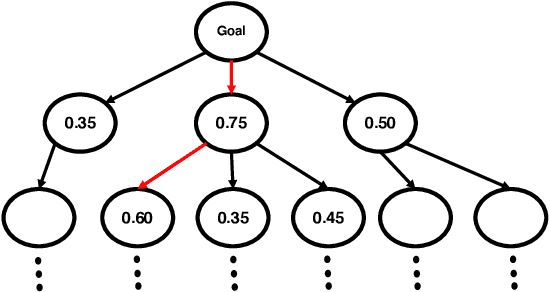Md. Sadman Sakib
Approximate Task Tree Retrieval in a Knowledge Network for Robotic Cooking
Jul 08, 2022



Abstract:Flexible task planning continues to pose a difficult challenge for robots, where a robot is unable to creatively adapt their task plans to new or unseen problems, which is mainly due to the limited knowledge it has about its actions and world. Motivated by a human's ability to adapt, we explore how task plans from a knowledge graph, known as the Functional Object- Oriented Network (FOON), can be generated for novel problems requiring concepts that are not readily available to the robot in its knowledge base. Knowledge from 140 cooking recipes are structured in a FOON knowledge graph, which is used for acquiring task plan sequences known as task trees. Task trees can be modified to replicate recipes in a FOON knowledge graph format, which can be useful for enriching FOON with new recipes containing unknown object and state combinations, by relying upon semantic similarity. We demonstrate the power of task tree generation to create task trees with never-before-seen ingredient and state combinations as seen in recipes from the Recipe1M+ dataset, with which we evaluate the quality of the trees based on how accurately they depict newly added ingredients. Our experimental results show that our system is able to provide task sequences with 76% correctness.
Functional Task Tree Generation from a Knowledge Graph to Solve Unseen Problems
Dec 04, 2021



Abstract:A major component for developing intelligent and autonomous robots is a suitable knowledge representation, from which a robot can acquire knowledge about its actions or world. However, unlike humans, robots cannot creatively adapt to novel scenarios, as their knowledge and environment are rigidly defined. To address the problem of producing novel and flexible task plans called task trees, we explore how we can derive plans with concepts not originally in the robot's knowledge base. Existing knowledge in the form of a knowledge graph is used as a base of reference to create task trees that are modified with new object or state combinations. To demonstrate the flexibility of our method, we randomly selected recipes from the Recipe1M+ dataset and generated their task trees. The task trees were then thoroughly checked with a visualization tool that portrays how each ingredient changes with each action to produce the desired meal. Our results indicate that the proposed method can produce task plans with high accuracy even for never-before-seen ingredient combinations.
 Add to Chrome
Add to Chrome Add to Firefox
Add to Firefox Add to Edge
Add to Edge